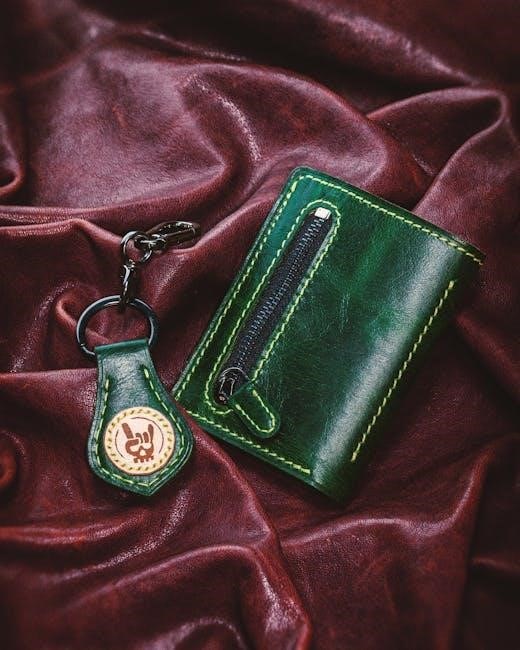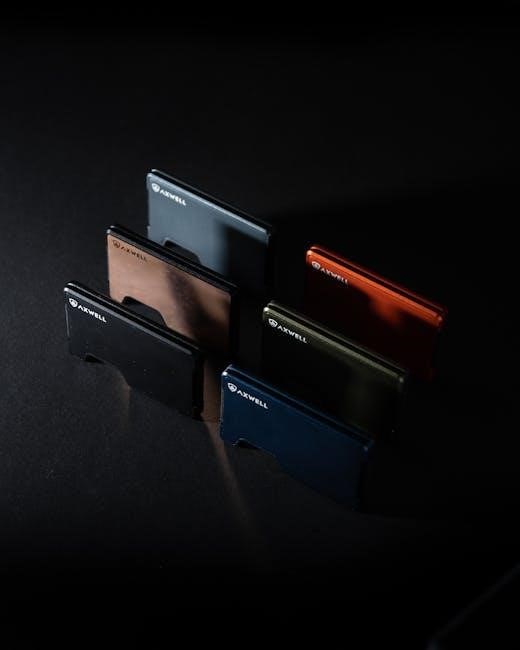Emotional intelligence, a crucial skill, involves recognizing emotions in oneself and others, understanding their impact, and managing them effectively for positive outcomes.
Examples demonstrate its power in teamwork, leadership, and navigating complex interactions, fostering stronger relationships and improved communication within diverse settings.
Cultivating emotional intelligence enhances problem-solving, builds trust, and creates a more cohesive and productive environment, benefiting both personal and professional life.
What is Emotional Intelligence?
Emotional Intelligence (EQ) extends beyond simply recognizing feelings; it’s about understanding the intricate interplay between emotions, thought processes, and behavior. It’s the capacity to perceive, use, understand, manage, and handle emotions – both your own and those of others. This skillset isn’t fixed; it’s a learnable and developable ability crucial for success in all facets of life.
Essentially, EQ allows individuals to navigate social complexities, build strong relationships, and make sound decisions, even under pressure. It involves empathizing with colleagues, responding calmly to criticism, and recognizing non-verbal cues. A high EQ doesn’t mean being overly emotional; rather, it signifies a heightened awareness and skillful regulation of emotional responses.
Furthermore, EQ is a predictor of both personal well-being and professional achievement, impacting teamwork, leadership, and overall productivity. It’s about leveraging emotional information to guide thinking and behavior, leading to more effective communication and stronger interpersonal connections.
The Four Branches of Emotional Intelligence
The Mayer-Salovey-Caruso Emotional Intelligence Test (MSCEIT) model outlines four key branches defining EQ. First, Perceiving Emotions involves accurately identifying emotions in oneself and others, utilizing non-verbal cues. Second, Using Emotions focuses on harnessing emotions to facilitate cognitive activities like problem-solving and creativity.
Third, Understanding Emotions encompasses comprehending emotional complexities, recognizing emotional blends, and predicting emotional transitions. Finally, Managing Emotions involves regulating one’s own emotions and influencing the emotions of others effectively.
These branches aren’t isolated; they build upon each other, creating a hierarchical system. Developing proficiency in each branch is crucial for maximizing overall emotional intelligence. Mastering these skills leads to improved communication, stronger relationships, and enhanced decision-making abilities in both personal and professional contexts.

Self-Awareness: The Foundation of EQ
Self-awareness, recognizing your own emotions, is the cornerstone of emotional intelligence, enabling understanding of their impact on thoughts and behaviors.
Identifying Your Own Emotions
Precisely pinpointing your feelings is the initial step towards heightened self-awareness, a core component of emotional intelligence. This involves moving beyond broad labels like “good” or “bad” and delving into the specific nuances of your emotional experience.
Are you feeling frustrated, anxious, or perhaps a blend of both? Regularly checking in with yourself – a practice often called an “emotional check-in” – can be incredibly beneficial. Pay attention to physical sensations; emotions often manifest as tightness in the chest, a racing heart, or clenched fists.
Keeping a journal dedicated to emotional exploration can also prove invaluable. Describe the situation, your thoughts, and, most importantly, the specific emotions you experienced. This practice builds your “emotional vocabulary” and allows you to recognize patterns over time. Recognizing these patterns is key to understanding triggers and managing reactions.
Recognizing the Impact of Your Emotions
Understanding how your emotions influence your thoughts, behaviors, and interactions is crucial for effective emotional intelligence. Emotions aren’t isolated events; they ripple outwards, affecting your decision-making, communication style, and even your physical health.
For instance, feeling stressed can lead to impulsive reactions or difficulty concentrating. Anger might manifest as aggressive communication, damaging relationships. Conversely, positive emotions like joy can enhance creativity and foster collaboration.
Consider how your emotional state impacts your work performance, your interactions with loved ones, and your overall well-being. By recognizing these connections, you gain the power to proactively manage your emotions and mitigate potentially negative consequences. This self-awareness is the foundation for more mindful and effective responses.
Self-Reflection Techniques for Enhanced Awareness
Regular self-reflection is paramount for cultivating emotional intelligence. Journaling provides a safe space to explore your feelings, identify triggers, and analyze your reactions to various situations. Ask yourself: What emotions did I experience? What caused them? How did I respond?
Mindfulness practices, like meditation, help you observe your emotions without judgment, increasing your awareness of internal states. Regularly reviewing past interactions – both positive and negative – can reveal patterns in your emotional responses.
Seeking feedback from trusted colleagues or friends offers valuable external perspectives; These techniques, consistently applied, deepen your understanding of your emotional landscape, fostering greater self-awareness and emotional regulation.

Self-Management: Controlling Impulses
Effective self-management involves strategies for stress reduction, adapting to change, and regulating emotions—essential skills for navigating life’s inevitable challenges.
Strategies for Managing Stress
Stress management is a cornerstone of self-management, requiring proactive techniques to mitigate its detrimental effects. Recognizing personal stressors is the initial step, followed by implementing coping mechanisms tailored to individual needs. Deep breathing exercises, mindfulness meditation, and progressive muscle relaxation are proven methods for calming the nervous system and reducing physiological arousal.
Regular physical activity serves as a powerful stress reliever, releasing endorphins that have mood-boosting effects. Prioritizing sufficient sleep is also crucial, as sleep deprivation exacerbates stress levels. Establishing healthy boundaries, learning to say “no” to excessive commitments, and delegating tasks when possible can prevent overwhelm.
Furthermore, cultivating a strong social support network provides a buffer against stress. Engaging in hobbies and activities that bring joy and relaxation offers a much-needed respite from daily pressures. Seeking professional help from a therapist or counselor can provide valuable guidance and support in developing effective stress management strategies.
Adapting to Changing Circumstances
Life is inherently dynamic, demanding flexibility and resilience in the face of constant change. Emotional intelligence plays a pivotal role in navigating these transitions effectively. Acknowledging and accepting that change is inevitable is the first step towards adaptation. Cultivating a growth mindset – believing that abilities can be developed through dedication and hard work – fosters a positive outlook.
Practicing cognitive reframing allows individuals to reinterpret challenging situations in a more constructive light. Focusing on what can be controlled, rather than dwelling on what cannot, empowers a sense of agency. Developing strong problem-solving skills and embracing a proactive approach to challenges are essential.
Maintaining open communication and seeking support from others during times of change can provide valuable perspective and encouragement. Viewing change as an opportunity for growth and learning, rather than a threat, promotes adaptability and resilience.
Emotional Regulation Techniques
Effective emotional regulation isn’t about suppressing feelings, but rather managing their intensity and expression. Deep breathing exercises, like diaphragmatic breathing, can quickly calm the nervous system during moments of stress or anxiety. Mindfulness meditation cultivates present moment awareness, allowing individuals to observe emotions without judgment.
Cognitive reappraisal involves challenging negative thought patterns and reframing situations in a more positive or realistic light. Practicing self-compassion – treating oneself with kindness and understanding – can buffer against the negative effects of difficult emotions.
Establishing healthy boundaries and prioritizing self-care are crucial for maintaining emotional equilibrium. Regular physical exercise releases endorphins, which have mood-boosting effects. Seeking professional support, such as therapy or counseling, can provide valuable tools and strategies for emotional regulation.

Social Awareness: Understanding Others
Social awareness involves empathizing with others, recognizing non-verbal cues, and actively listening to understand perspectives, fostering stronger interpersonal connections.
Empathy and Perspective-Taking
Empathy, a cornerstone of social awareness, extends beyond simply recognizing another’s emotions; it’s about truly feeling with them, understanding their experiences as if they were your own.
Perspective-taking complements empathy by actively trying to see a situation from another person’s viewpoint, acknowledging their unique background, beliefs, and motivations.
This isn’t about agreeing with their perspective, but rather understanding why they hold it, fostering compassion and reducing judgment.
In practice, this means pausing before reacting, asking clarifying questions, and genuinely listening to understand, not to respond.
For example, an account manager recognizing a client’s disappointment and proactively seeking to understand their expectations demonstrates powerful empathy and perspective-taking.
These skills are vital for building trust, resolving conflicts, and strengthening relationships, both personally and professionally.
Recognizing Non-Verbal Cues
Non-verbal communication, encompassing body language, facial expressions, tone of voice, and even posture, often reveals more than spoken words.
Developing the ability to accurately interpret these cues is crucial for enhancing social awareness and understanding the true emotions of others.
For instance, crossed arms might indicate defensiveness, while a genuine smile engages the entire face, not just the mouth.
Paying attention to subtle shifts in tone can reveal underlying frustration or anxiety, even if the words themselves remain neutral.
However, it’s vital to consider context and cultural differences, as non-verbal cues can vary significantly.
Accurately reading these signals allows for more empathetic responses and prevents misinterpretations, fostering stronger connections and more effective communication.
This skill is particularly valuable in navigating difficult conversations and building rapport.
Active Listening Skills
Active listening transcends simply hearing words; it involves fully concentrating, understanding, responding, and remembering what is being said.
This crucial skill demonstrates respect and builds trust, fostering deeper connections with others.
Techniques include maintaining eye contact, nodding to show engagement, and providing verbal affirmations like “I understand.”
Paraphrasing and summarizing the speaker’s points ensures accurate comprehension and allows them to clarify any misunderstandings.
Resisting the urge to interrupt or formulate a response while the other person is speaking is paramount.
Instead, focus on truly grasping their perspective and emotional state, demonstrating empathy and validating their feelings.
Effective active listening is a cornerstone of strong relationship management and conflict resolution.

Relationship Management: Building Connections
Relationship management leverages emotional intelligence for effective communication, conflict resolution, and fostering trust—essential for strong, lasting connections.
Effective Communication Strategies
Effective communication, a cornerstone of strong relationships, requires more than just conveying information; it demands emotional awareness and skillful delivery. Practicing active listening – truly hearing and understanding another’s perspective – is paramount. This involves paying attention to both verbal and non-verbal cues, demonstrating empathy, and asking clarifying questions.
Furthermore, framing messages thoughtfully, considering the recipient’s emotional state, significantly impacts how they are received. Avoiding accusatory language and focusing on “I” statements promotes constructive dialogue. Responding calmly to criticism, rather than defensively, showcases emotional regulation and fosters trust.
Acknowledging others’ feelings, even when disagreeing, validates their experience and opens the door for collaborative problem-solving. Ultimately, mastering these strategies builds rapport, minimizes misunderstandings, and strengthens connections, leading to more productive and fulfilling interactions.
Conflict Resolution Techniques
Navigating conflict constructively requires a blend of self-awareness and emotional intelligence. A crucial first step is recognizing your own emotional response and managing impulses to avoid escalation. Active listening – truly understanding the other party’s perspective – is paramount, even when disagreeing.
Employing “I” statements to express your needs and feelings, rather than accusatory “you” statements, fosters a less defensive environment. Seeking common ground and focusing on shared goals can shift the focus from opposition to collaboration.
Diffusing tense situations often involves acknowledging the other person’s emotions and validating their experience. When emotions run high, taking a break to regain composure can prevent regrettable reactions. Ultimately, successful conflict resolution prioritizes understanding, empathy, and a commitment to finding mutually acceptable solutions.
Building Trust and Rapport
Establishing trust and rapport hinges on demonstrating genuine empathy and consistently exhibiting integrity. Active listening, coupled with non-verbal cues like maintaining eye contact and nodding, signals attentiveness and respect. Sharing appropriate personal experiences can foster connection, but avoid oversharing or dominating the conversation.
Reliability is key; consistently following through on commitments builds confidence. Recognizing and appreciating others’ contributions, both publicly and privately, strengthens bonds.
Emotional intelligence allows you to adapt your communication style to resonate with different personalities, creating a sense of ease and understanding. Authenticity is paramount – people can detect insincerity; By prioritizing genuine connection and mutual respect, you cultivate lasting relationships built on trust and rapport.

EQ in the Workplace: Boosting Productivity
Emotional intelligence amplifies teamwork, enhances problem-solving, and fosters a cohesive environment where every team member performs optimally, boosting overall productivity.

Improving Teamwork and Collaboration
Emotional intelligence significantly elevates teamwork and collaboration by fostering a deeper understanding amongst team members. Recognizing and responding to colleagues’ emotional cues reduces misunderstandings, improving team cohesion by approximately 40%, as demonstrated in practical applications.
When individuals possess high EQ, they’re better equipped to navigate disagreements constructively, offering empathetic perspectives and actively listening to diverse viewpoints. This creates a psychologically safe space where open communication flourishes, and innovative ideas are readily shared.
Furthermore, emotionally intelligent teams demonstrate enhanced problem-solving capabilities, leveraging collective strengths and mitigating potential conflicts. A culture valuing empathy and emotional management amplifies these skills, leading to a more productive and harmonious work environment.
Leadership and Emotional Intelligence
Effective leaders demonstrably possess high emotional intelligence, understanding their employees’ needs and building strong, sustainable teams. This involves recognizing and responding appropriately to the emotional states of team members, fostering a supportive and motivating environment.
Emotionally intelligent leaders don’t just focus on tasks; they prioritize building rapport and trust, creating a sense of psychological safety where individuals feel comfortable taking risks and contributing their best work. They skillfully navigate difficult conversations, offering constructive feedback with empathy and understanding.
Such leadership styles inspire loyalty, enhance engagement, and ultimately drive better performance. By modeling emotional awareness and regulation, leaders cultivate a culture of EQ throughout the organization, amplifying its positive impact.
Case Studies: EQ Improving Workplace Outcomes
One instance showcased how emotional awareness practice reduced misunderstandings by 40% and significantly improved team cohesion, demonstrating the tangible benefits of EQ training. Another example involved salvaging a client relationship when an account manager, recognizing signs of disappointment, paused to explore the client’s expectations.
This emotionally intelligent response transformed a potential loss into a strengthened partnership and an expanded contract, highlighting the power of empathy and active listening. These scenarios illustrate how EQ fosters better communication, conflict resolution, and ultimately, improved business results.
Such outcomes underscore that investing in emotional intelligence isn’t merely a “soft skill” development, but a strategic imperative for organizational success.

EQ in Personal Life: Enhancing Relationships
Emotional intelligence strengthens bonds through navigating difficult conversations, fostering empathy, and improving romantic connections, leading to deeper, more fulfilling personal relationships.
Navigating Difficult Conversations

Difficult conversations are inevitable in any relationship, but emotional intelligence provides the tools to navigate them constructively. Recognizing your own emotional state—and that of the other person—is paramount. Before engaging, practice self-reflection to understand your triggers and desired outcomes.
Employ active listening skills, truly hearing and acknowledging the other person’s perspective, even if you disagree. Respond calmly, avoiding defensiveness, and instead, ask exploratory questions to clarify understanding. Empathy is key; attempt to see the situation from their viewpoint.
Effective communication involves expressing your needs and feelings assertively, but respectfully. Focus on “I” statements rather than accusatory “you” statements. Remember, the goal isn’t necessarily to “win” the conversation, but to foster understanding and strengthen the relationship. A salvaged client relationship exemplifies this, turning potential loss into partnership.
Strengthening Family Bonds
Strong family bonds thrive on emotional connection, and emotional intelligence is the cornerstone of that connection. Practicing empathy allows you to understand each family member’s feelings and perspectives, fostering a sense of validation and belonging. Active listening—truly hearing and acknowledging their experiences—builds trust and strengthens communication.
Recognizing non-verbal cues, like body language and tone of voice, provides deeper insight into unspoken emotions. Managing your own emotional reactions, especially during disagreements, prevents escalation and promotes constructive dialogue. Respond calmly, avoiding criticism or blame.
Regular self-reflection on your interactions can reveal patterns and areas for improvement. Creating a safe space where family members feel comfortable expressing themselves authentically is vital. This fosters resilience and a stronger, more supportive family unit, navigating challenges together.
Improving Romantic Relationships
Emotional intelligence dramatically enhances romantic relationships by fostering deeper understanding and connection. Practicing empathy allows partners to truly see and feel each other’s experiences, strengthening intimacy. Active listening, beyond just hearing words, involves acknowledging emotions and validating perspectives.
Recognizing non-verbal cues—facial expressions, body language—reveals unspoken needs and feelings. Managing personal emotional reactions, particularly during conflict, prevents destructive patterns. Responding calmly, rather than defensively, opens space for constructive dialogue.
Navigating difficult conversations requires vulnerability and a willingness to understand your partner’s viewpoint. Building trust through consistent emotional honesty and reliability is paramount. Acknowledging and appreciating each other’s emotional needs cultivates a lasting, fulfilling partnership.

Developing Your Emotional Intelligence
Practical exercises, like self-reflection and seeking feedback, are vital for EQ growth. Resources abound, offering guidance for continuous improvement and long-term benefits.
Practical Exercises for EQ Growth
Engaging in regular self-reflection is paramount; journaling about emotional responses to situations provides valuable insights. Practice active listening – truly hear and understand others’ perspectives before formulating a response. A powerful exercise involves identifying personal emotional triggers and developing strategies to manage reactions constructively.
Role-playing challenging conversations can build confidence and refine communication skills. Seek feedback from trusted colleagues or friends regarding your emotional impact on others; Regularly practice empathy by consciously attempting to understand situations from another person’s viewpoint.
Mindfulness meditation cultivates self-awareness and emotional regulation. Consider keeping an “emotional log” to track feelings throughout the day, noting triggers and responses. These consistent efforts will demonstrably enhance your emotional intelligence over time, fostering stronger relationships and improved self-management;
Resources for Further Learning
Daniel Goleman’s “Emotional Intelligence” remains a foundational text, offering comprehensive insights into the core concepts and practical applications of EQ. Travis Bradberry and Jean Greaves’ “Emotional Intelligence 2.0” provides a skills-based approach with self-assessment tools.
Online platforms like Coursera and Udemy offer courses specifically focused on developing emotional intelligence, often led by industry experts. The Greater Good Science Center at UC Berkeley provides research-backed articles and exercises on cultivating emotional well-being.
Numerous podcasts, such as “The Emotional Intelligence Podcast,” explore various facets of EQ and offer actionable strategies. Books on mindfulness and communication, like “Nonviolent Communication” by Marshall Rosenberg, complement EQ development, fostering deeper understanding and connection.
The Long-Term Benefits of EQ Development
Sustained EQ development fosters enhanced resilience, enabling individuals to navigate challenges with greater composure and adaptability. Improved relationships, both personal and professional, become a natural outcome of increased empathy and effective communication.
Career advancement often follows, as emotionally intelligent leaders inspire trust, build strong teams, and drive positive outcomes. Reduced stress levels and improved mental well-being contribute to a higher quality of life, promoting overall health.
Furthermore, heightened self-awareness facilitates better decision-making, leading to more fulfilling choices aligned with personal values. A commitment to ongoing EQ growth cultivates a continuous cycle of self-improvement and positive impact, benefiting individuals and society alike.




























































